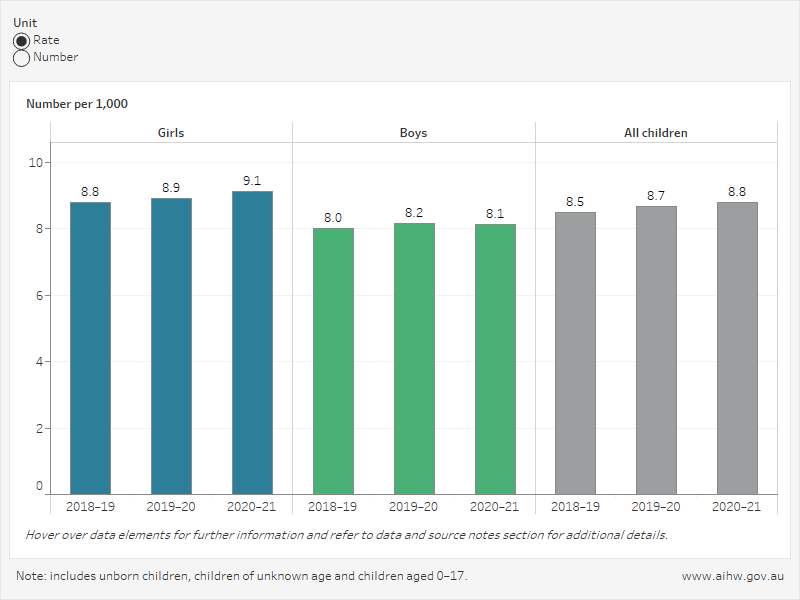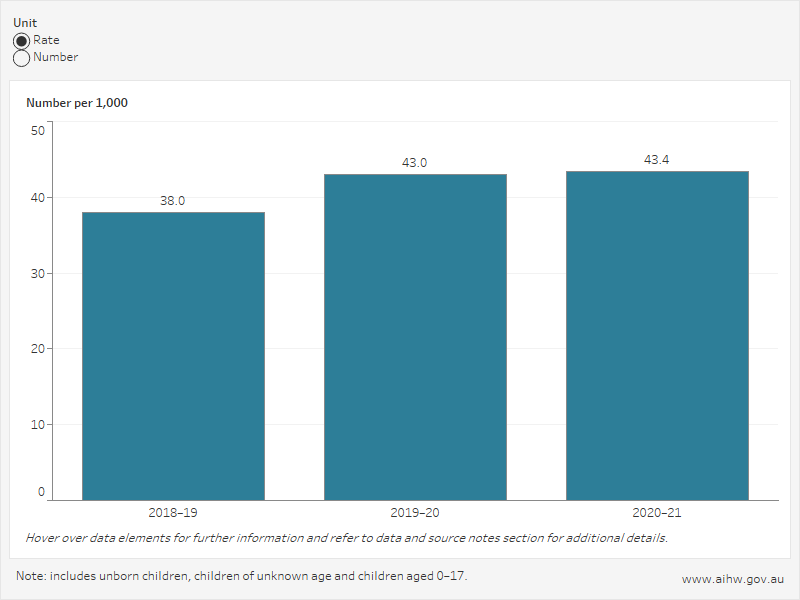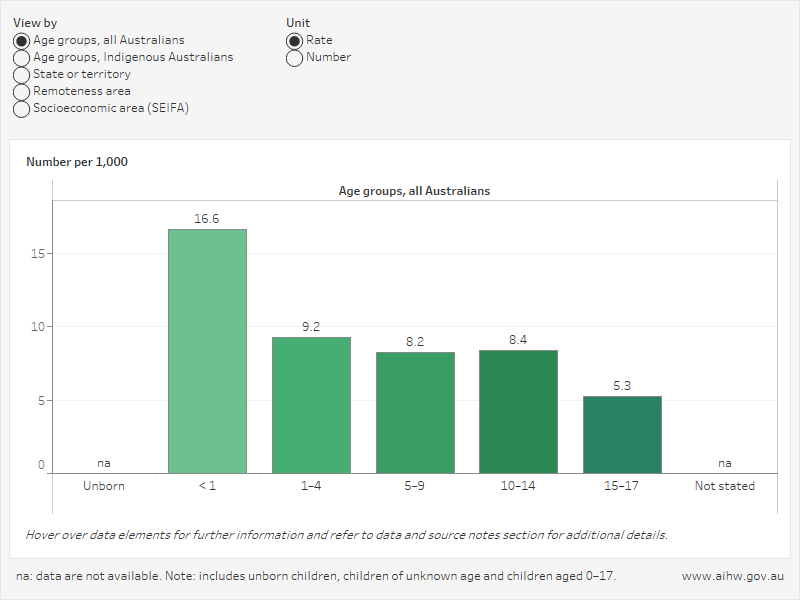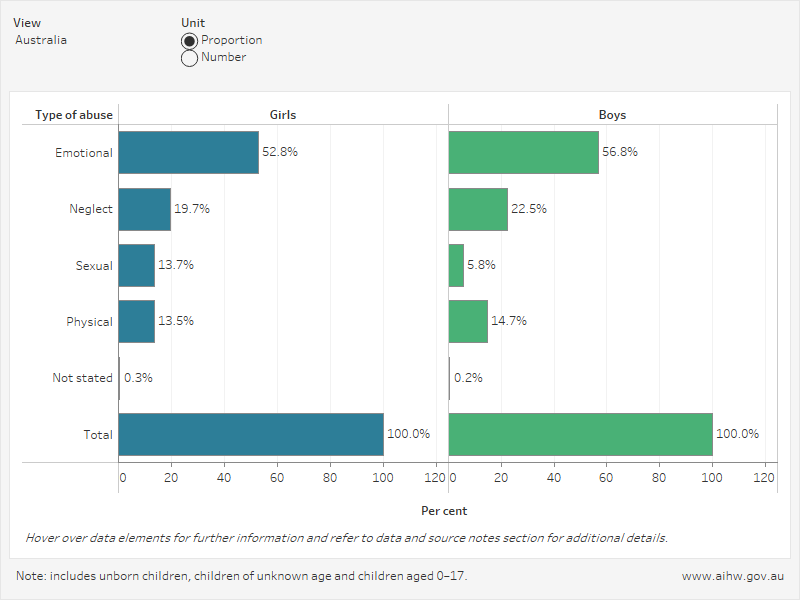Substantiated notifications of abuse and/or neglect
Children aged under 18 who experience abuse and/or neglect may have contact with the child protection system. The substantiation of a child protection notification is the conclusion (following an investigation) that there was reasonable cause to believe a child had been, was being, or was likely to be abused, neglected, or otherwise harmed. Data on substantiated notifications (substantiations) of abuse and/or neglect, including those perpetrated by family members, are drawn from the AIHW Child Protection National Minimum Data Set (CP NMDS).
The visualisation below shows the number and rate (number per 1,000) of children who were the subject of substantiations of abuse and/or neglect from 2018–19 to 2020–21 by sex. The number of substantiations increased from 47,500 in 2018–19 to 49,700 in 2020–21 (a 4.6% increase).
Children who were the subject of substantiations, by sex, 2018–19 to 2020–21

Source data: Substantiated notifications of abuse and/or neglect tables (60KB XLSX)
The visualisation below shows the number and rate (number per 1,000) of Aboriginal and Torres Strait Islander children who were the subject of substantiations of abuse and/or neglect from 2018–19 to 2020–21. Between 2018–19 and 2020–21, the number of Indigenous children who were the subject of substantiations increased from 12,600 to 14,600, an increase of 16.0%.
Indigenous children who were the subject of substantiations, 2018–19 to 2020–21

Population groups
Examining population groups with higher proportions of substantiated notifications of abuse and/or neglect can help to identify those groups that may benefit from more targeted programs and services.
The following visualisation allows users to view the number and rate (number per 1,000 children) of children who were the subject of substantiations of abuse and/or neglect by select population groups. In 2020–21, rates of substantiation were:
- highest for children aged less than one, compared to all other age groups.
- almost four times as high for Indigenous children aged less than one, compared to Indigenous children aged 15–17.
- highest for those living in the Northern Territory.
- highest for those living in very remote areas.
Children who were the subject of substantiations, for select population groups, 2020–21

The following visualisation shows the number and proportion of children who were the subject of substantiations of abuse and/or neglect by primary type of abuse. In Australia in 2020–21, emotional abuse was the most common type of primary abuse for both girls and boys.
Children who were the subject of substantiations, by primary type of abuse and neglect, by sex, 2020–21

Notes
- Substantiations refer to cases that were notified to relevant authorities during the reference year (for example, 1 July 2020 to 30 June 2021) and investigated (with the investigation finalised by 31 August 2021).
-
Children may be the subject of more than one substantiation throughout the year. Children rather than substantiations are the reporting unit here.
-
Time series data for substantiations are limited due changes in state and territory legislation, policy/practice, and information management systems which reduce the ability to accurately compare data over long periods.
-
Data for children who were the subject of substantiations are not comparable across jurisdictions due to differences in the way jurisdictions collect and report data on substantiations, including data on abuse type.
-
‘All children’ includes children whose sex was unknown.
-
Unborn children may be covered under child protection legislation and, along with children of unknown age, are included in all totals and relevant population group counts and rates. However, they are excluded from age-specific (including 'less than one' category) counts and rate calculations.
-
Population data are not available for creating rates for unborn children and children of unknown age.
-
Remoteness area reporting excludes 1,441 records due either to missing location data, or because they were unable to be mapped to Remoteness Areas.
-
SEIFA reporting excludes 1,487 records due either to missing location data, or because they were unable to be mapped to geographical areas to calculate the index.
- If a child was the subject of more than one type of abuse or neglect as part of the same notification, the type of abuse or neglect reported is the one considered by the child protection workers to cause the most harm to the child. Where a child is the subject of more than one substantiation during the year, the type of abuse or neglect reported is the one associated with the first substantiation decision relating to the earliest notification during the year. As such, only the abuse type for the first substantiation in the year that is most likely to place the child at risk, or be most severe in the short term, is reported.
-
Some data may not match those published in previous Child protection Australia publications due to retrospective updates to data.
Sources


